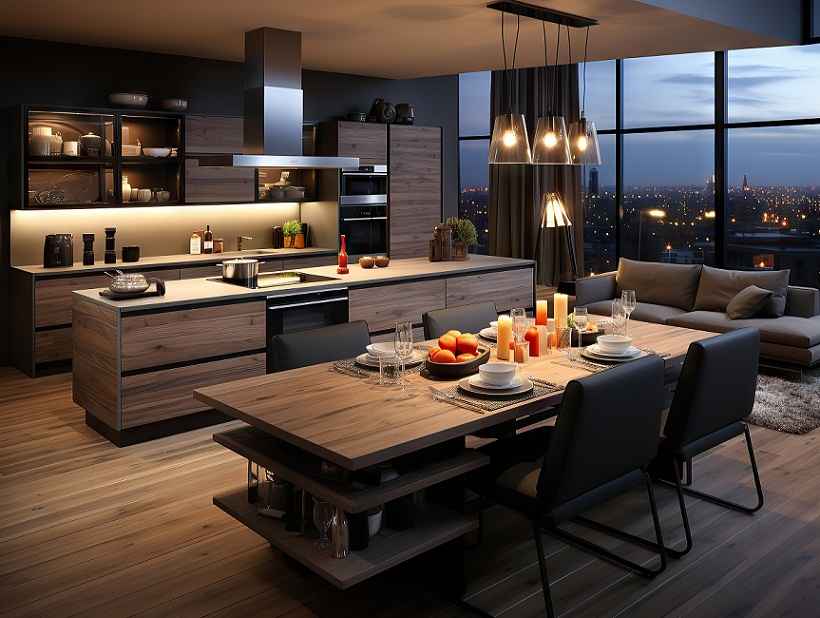The kitchen is the heart of the home, where families gather, meals are prepared, and memories are made. The right lighting can transform this essential space, enhancing both its functionality and its beauty. This comprehensive guide will equip you with the knowledge and tools needed to select the perfect kitchen lighting, creating a space that is both inviting and efficient.
Understanding the Basics of Kitchen Lighting
Before delving into specific fixtures and bulbs, it’s essential to understand the different types of kitchen lighting and their purposes.
Types of Lighting:
- Ambient lighting: Provides general illumination throughout the kitchen, typically achieved through ceiling lights or recessed lighting.
- Task lighting: Focused illumination for specific areas where detailed work is done, such as countertops, sinks, and stovetops. This is often achieved with under-cabinet lighting, pendant lights, or track lighting.
- Accent lighting: Highlights specific features or areas in the kitchen, creating visual interest and depth. This could involve spotlights, strip lighting, or picture lights.
Importance of Layered Lighting:
Layering different types of lighting is crucial for creating a well-balanced and functional kitchen environment. It ensures adequate illumination for various tasks while also adding visual interest and ambiance.
Planning Your Kitchen Lighting
The first step towards achieving perfect kitchen lighting is carefully planning your layout and identifying key areas that require illumination.
Assessing Your Kitchen Layout:
- Consider the size of your kitchen and its overall layout.
- Identify any unique features or challenges, such as high ceilings, open floor plans, or limited natural light.
- Determine the primary function of your kitchen and how you use the space.
Identifying Key Areas for Lighting:
- Workspaces: Prioritize task lighting for areas like countertops, sinks, and stovetops.
- Dining areas: Ensure adequate ambient lighting for dining tables and breakfast bars.
- Cabinets and shelves: Accent lighting can highlight decorative items or improve visibility inside cabinets.
Choosing the Right Fixtures
With a clear understanding of your lighting needs, you can begin selecting the appropriate fixtures.
Types of Light Fixtures:
- Pendant lights: Suspended from the ceiling, often used over kitchen islands or countertops.
- Chandeliers: Decorative fixtures that provide ambient lighting and a touch of elegance.
- Recessed lighting: Installed within the ceiling, offering a clean and minimalist look.
- Under-cabinet lighting: Task lighting installed under cabinets to illuminate work surfaces.
Materials and Styles:
- Choose fixtures that complement your kitchen’s overall design style, whether modern, traditional, or transitional.
- Popular materials include glass, metal, and wood, each offering unique aesthetics and functionality.
Selecting the Right Bulbs
The choice of bulbs significantly impacts the overall ambiance and functionality of your kitchen lighting.
Types of Bulbs:
- LED: Energy-efficient, long-lasting, and available in a wide range of color temperatures and brightness levels.
- Incandescent: Traditional bulbs that emit warm light but are less energy-efficient.
- Fluorescent: Energy-efficient but often emit a harsh light, making them less suitable for kitchens.
Color Temperature and Brightness:
- Color temperature, measured in Kelvin (K), affects the ambiance of the light. Warm white (2700-3000K) creates a cozy atmosphere, while cool white (4000-4500K) is brighter and more invigorating.
- Choose the appropriate brightness (lumens) for different areas based on their function. For example, task lighting requires higher lumens than ambient lighting.
Energy Efficiency and Sustainability
Opting for energy-efficient lighting solutions not only saves you money on energy bills but also contributes to a more sustainable future.
Benefits of Energy-Efficient Lighting:
- Reduced energy consumption, leading to lower electricity bills.
- Decreased environmental impact through lower carbon emissions.
Smart Lighting Solutions:
Smart bulbs and controls offer advanced features like dimming, color changing, and scheduling, allowing you to customize your kitchen lighting for different occasions.
Installation and Maintenance Tips
Whether you choose to install the lighting yourself or hire a professional, proper installation and maintenance are crucial.
Hiring a Professional vs. DIY:
- For complex installations or electrical work, consider hiring a licensed electrician.
- If you’re comfortable with basic DIY tasks, you can handle simple installations like under-cabinet lighting.
Maintenance Tips:
- Regularly clean light fixtures to maintain their appearance and ensure optimal performance.
- Replace bulbs promptly when they burn out to avoid uneven illumination.
Common Mistakes to Avoid
Avoid these common pitfalls to ensure perfect kitchen lighting:
- Overlooking layered lighting: Ensure a balance of ambient, task, and accent lighting for optimal functionality and ambiance.
- Ignoring energy efficiency: Choose energy-efficient bulbs and fixtures to save money and reduce your carbon footprint.
- Poor placement of fixtures: Carefully plan the placement of fixtures to avoid shadows and ensure adequate illumination in key areas.
Case Studies and Examples
For inspiration, explore real-life examples of perfect kitchen lighting.
- Before and after transformations showcasing the impact of effective lighting design.
- Testimonials from homeowners who have successfully implemented perfect kitchen lighting in their homes.
Frequently Asked Questions (FAQs)
- What is the best type of lighting for a kitchen? The best type of lighting depends on your specific needs and preferences. A combination of ambient, task, and accent lighting is generally recommended.
- How do I choose the right size of light fixtures? The size of the fixture should be proportional to the size of the area being illuminated. For example, larger fixtures are suitable for larger spaces like kitchen islands, while smaller fixtures are appropriate for task lighting over countertops.
- Can I install kitchen lighting myself? You can install some simple lighting fixtures yourself, such as under-cabinet lighting. However, for complex installations or electrical work, it’s best to hire a licensed electrician.
Conclusion
By following the guidelines in this comprehensive guide, you can create perfect kitchen lighting that enhances the functionality, beauty, and overall ambiance of your home’s heart. Embrace the possibilities and transform your kitchen into a space that inspires creativity, fosters connection, and brings joy to your daily life.


